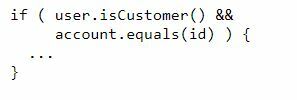An Interest In:
Web News this Week
- April 27, 2024
- April 26, 2024
- April 25, 2024
- April 24, 2024
- April 23, 2024
- April 22, 2024
- April 21, 2024
Java Null Pointer Exception: One Tiny Thing That's Killing Your Chances of Solving It.
While the issue we're covering here isn't exclusive to NullPointerExceptions, it makes an excellent simple example. In the end, they're the most frequently encountered problem within Java applications in production.
You've encountered a NullPointerException thrown up, and you want to be made conscious of this?
The worst-case scenario is that your customers suffer, and your staff is made aware of this via a furious flood of Twitter messages.
In the best scenario, it does not pass one of your tests, and you can prevent it from being in production.
The usual case is that the exceptions are frequent. However, you're not sure whether they're significant or not.
Are you looking to know more about Java and pursuing a career in Core Java & J2EE basic and advanced concepts and popular frameworks like Hibernate, Spring & SOA.? You should check for the Java certification.
For this experiment, let us suppose that we have an issue in our possession that we have to resolve, so identification is out of the question (for the moment). The initial point of departure for the investigation process will usually be the application logs and the stack trace. There's also the chance that the exception was not recorded, and we refer to them as "silent killers" of the Java application.
- Only one possible value could've been null in the line. Maybe we've also recorded it in several different places within the code to pinpoint the problematic step. It could be something like:

The "user" or "user" subject is undoubtedly the root of the problem.
- Murphy's law. If something goes wrong, then it will be wrong. Think about the following scenario:

We're not sure whether it's"account" or the "user" and "account" that are, in fact, null, which means we're in limbo.
Like the late Mr. T once said, "Life's difficult; however, I'm stronger." Let's explore the possibilities of solutions to aid in the advancement of our investigation.
Option #1: breaking down complicated lines of code
In the example above, the If statement could have been reduced to:
The stack trace would contain the correct line number, moving quicker. This is another reason separating aggregate operations on streams is a good idea.
Some style guides adhere to the same principles to address readability issues. Please look at the article comparing Java-style guides from firms such as Google, Twitter, and Mozilla (and Pied Piper).
Solution #2 Solution #2: More null checks
This is the easiest method to keep nulls at bay and ensure that the rogue values don't get into essential areas. Null-checked code isn't pretty. However, it can be an essential evil.
Our previous article on JVM JIT optimizing methods discussed how the JVM utilizes the trap mechanism commonly used in the industry to circumvent unnecessary null checks that can affect the performance.
Solution #3: More verbose logs
If there's an issue, it's likely to be logged as a message with additional information. Whether it contains valuable details or not is a different matter.
The next step might be adding information to the message or including additional log statements that could provide some insight into the route to... explosive event. This creates the debugging paradox, hoping this error will never happen again to stop it from occurring once more.
To learn more about ways to troubleshoot production servers, look up this article from the High Scalability blog (an excellent resource for everything about high-scalability systems).
Solution #4: Develop the Continuous Reliability mindset
Improved code quality and ensuring the reliability of applications are complex issues to resolve. We have made some assumptions in this article to simplify things, but, as you've guessed, the application error is a highly complex issue in actuality.
Continuous Reliability (CR) assists in the definition of an innovative method of making sure that software is of high performance in the Continuous Integration (CI) as well as Continuous Delivery (CD) pipelines.
Aiding in the promotion of "Shift left," "Shift Right," and Developer Productivity initiatives through providing structured methods for finding and resolving fundamental software problems based on the quality of gates and observability for applications and feedback loops that are contextual.
is a company that has a mission to make sure you're We're focused on making the goal of Continuous Reliability a reality in the context of mission-critical Java and .NET applications.
When an exception, log warning, or error occurs, captures and analyzes it, assisting in determining its priority and providing an image of the complete state of the variable at the time of error to the code responsible for it.
Original Link: https://dev.to/varunsngh007/java-null-pointer-exception-one-tiny-thing-thats-killing-your-chances-of-solving-it-2dok
Dev To
 An online community for sharing and discovering great ideas, having debates, and making friends
An online community for sharing and discovering great ideas, having debates, and making friendsMore About this Source Visit Dev To


